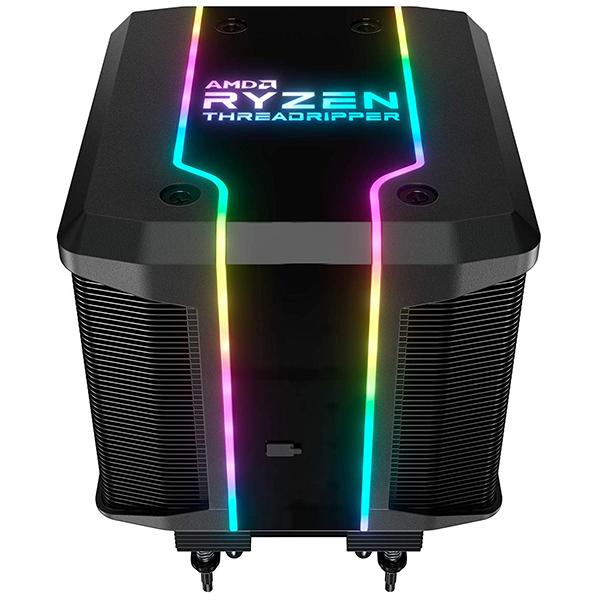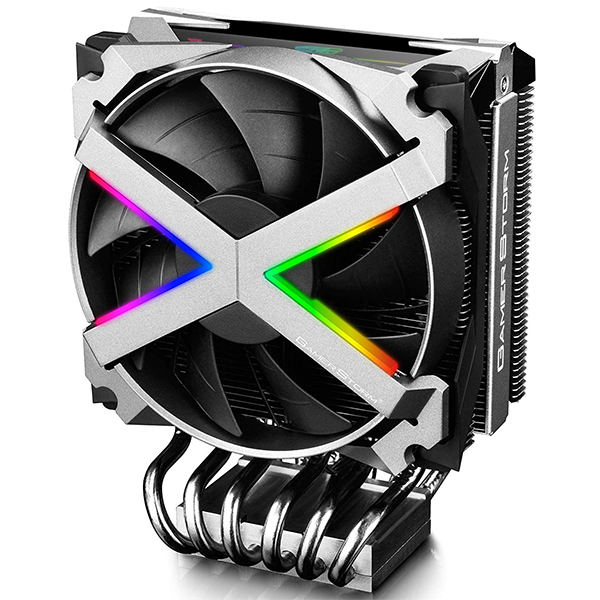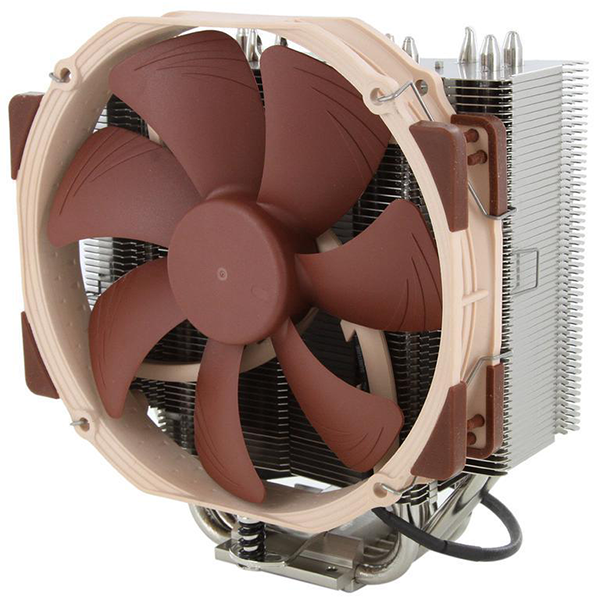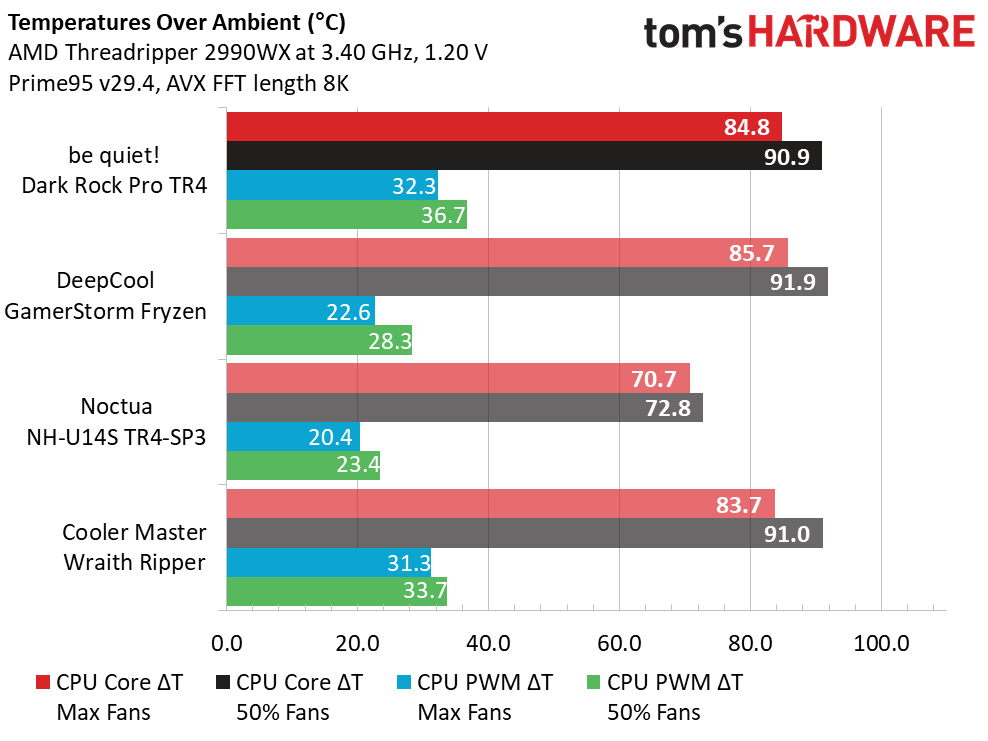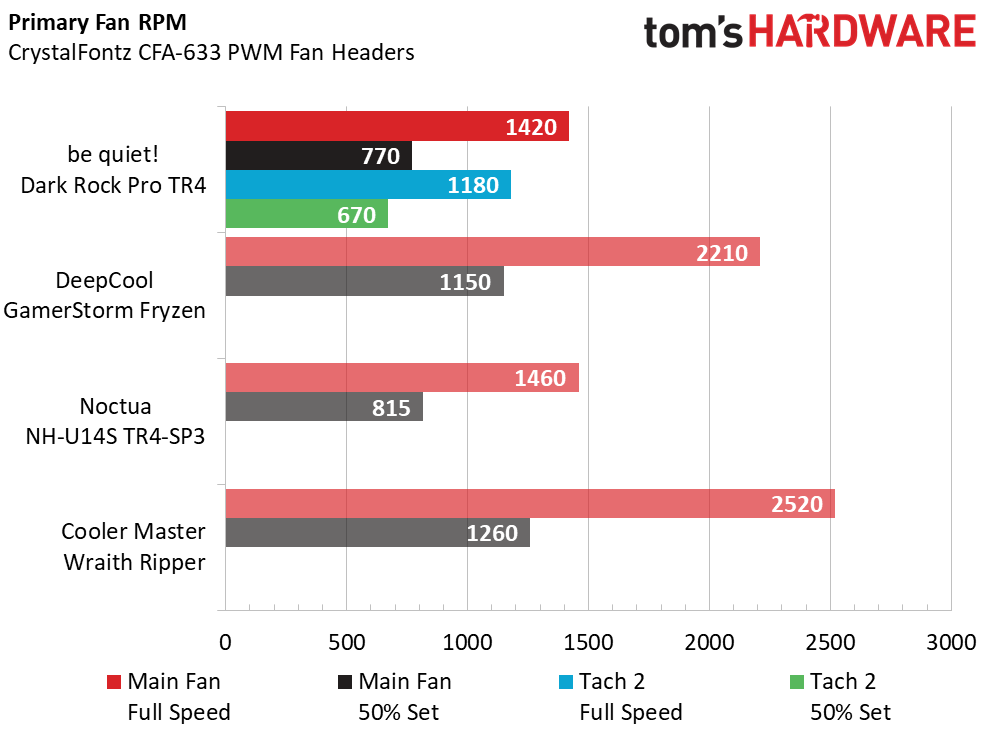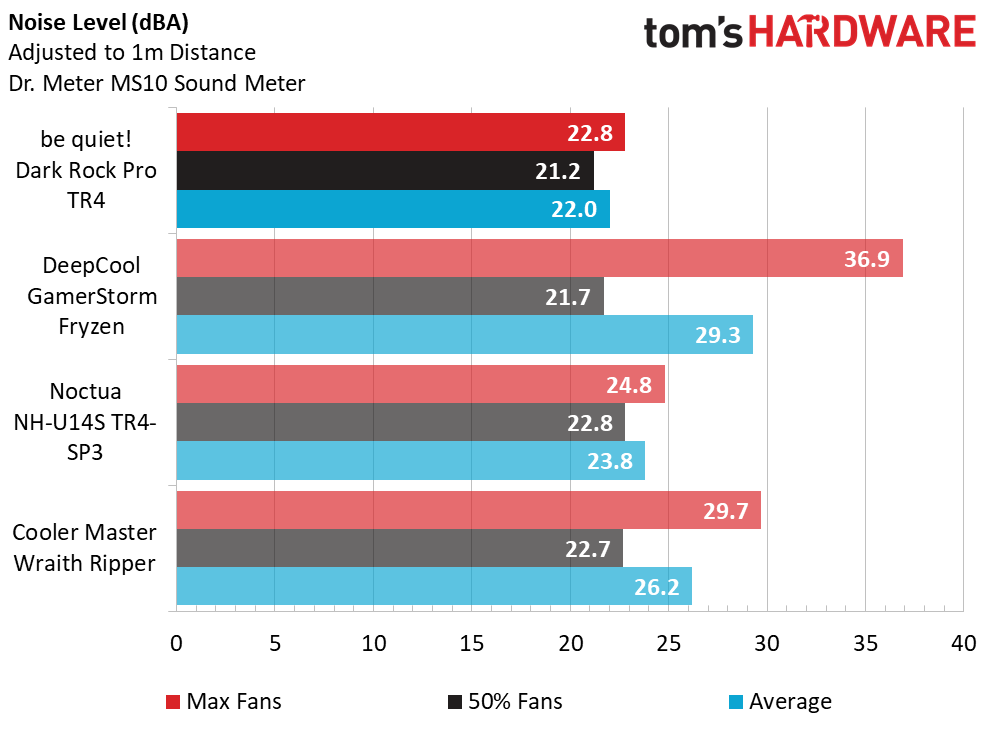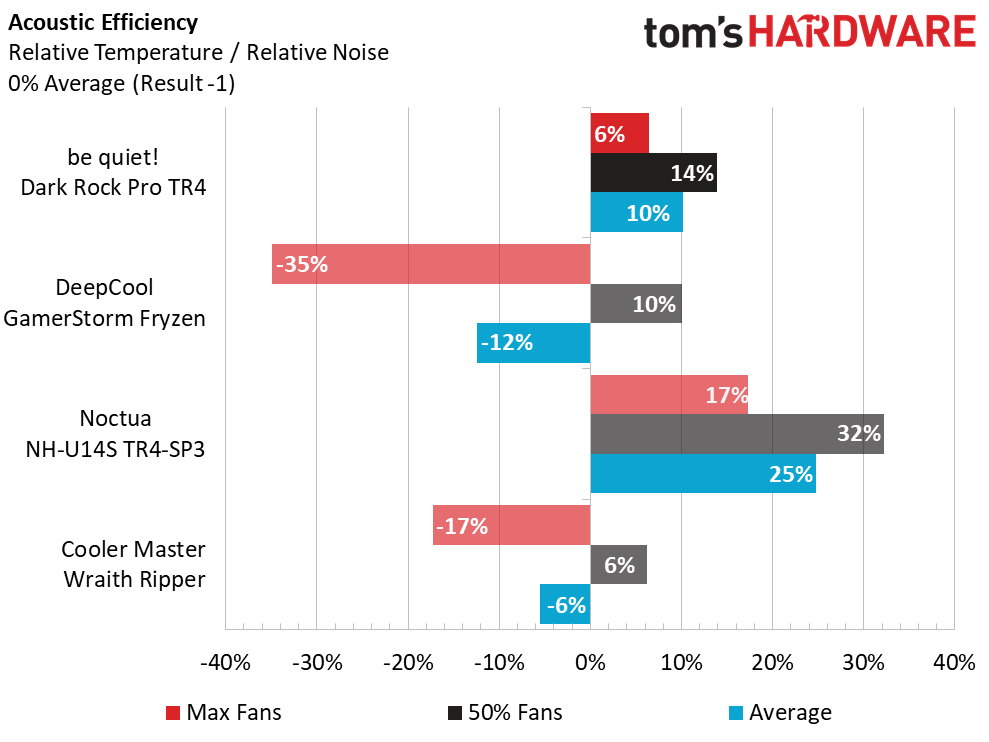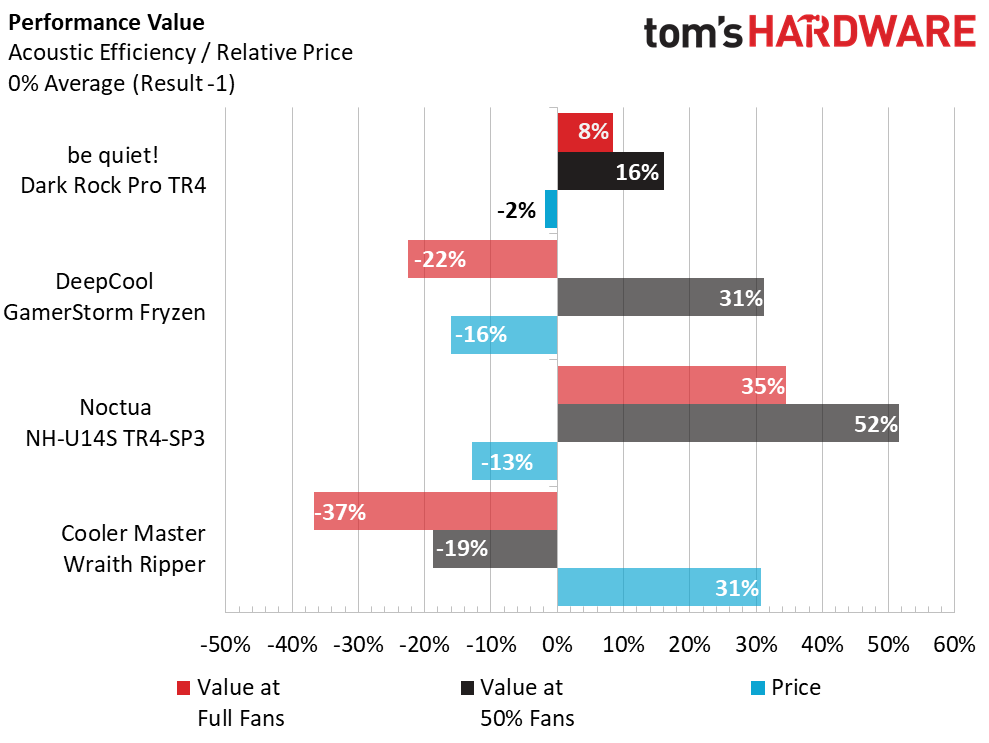be quiet! Dark Rock Pro TR4 Review: Threadripping in Stealth Mode
Why you can trust Tom's Hardware
Comparison Coolers, Testing Results and Conclusion
Comparison Coolers
We compared the Noctua be quiet! Dark Rock Pro TR4 against other coolers on our 32-core 2990WX Threadripper CPU, which runs at 3.4Ghz and 1.20v on our Gigabyte X399 Aurous Xtreme motherboard. The system is mounted inside our standard Corsair Graphite 760T chassis. We’ll take a look at the be quiet! Dark Rock Pro TR4 alongside the DeepCool Gamer Storm Fryzen, the Noctua NH-U14S TR4-SP3 and the Cooler Master Wraith Ripper.
Testing Results
The Dark Rock Pro TR4 doesn’t give us the lowest thermal results of the group, but does fall in line with the GamerStorm Fryzen and the Wraith Ripper. All three fall behind the 140mm Noctua NH-U14S.
Equipped with a pair of cooling fans (one 120mm & one 135mm), the Dark Rock Pro TR4 provides the slowest fan speeds of the group, while still maintaining the same performance of others in the testing comparison.
Low fan speeds usually translate directly into lower decibel levels, and that holds true here, as the be quiet! Dark Rock Pro TR4 provides whisper-quiet cooling over a large heatpipe framework.
We define acoustic efficiency by how well a specific cooler handles the thermal load testing against registered relative sound levels compared to the other hardware in the comparison test group. The Dark Rock Pro TR4 and Noctua NH-U14S are the only two coolers of the quartet which manage to post positive efficiencies.
Conclusion
Performance value assesses our acoustic efficiency chart while also evaluating individual product cost against average cost. Once again, the Dark Rock Pro TR4 and Noctua NH-U14S TR4-SP4 manage to post positive value at both 50% and 100% fan speeds, while also posting below-group-average price tags.
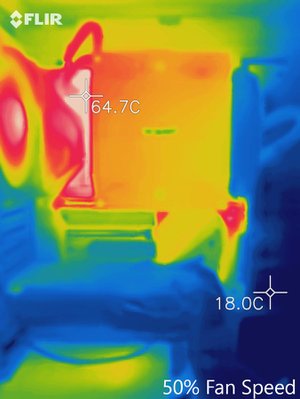
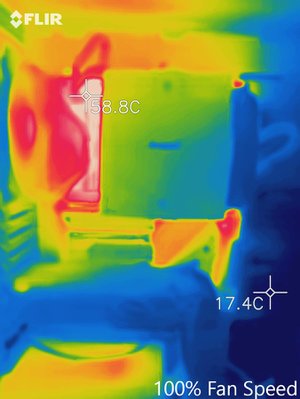
Thermal imaging from our FLIR ONE Pro camera shows similar thermal loading across both 50% and 100% fan speeds, showing slight increases from the middle of the Dark Rock Pro TR4 and almost diagonally upwards to the back of the case. This indicates that as airflow moves the thermal load through the cooler laterally toward the back to the rear discharge, it also shows a slight incline due to the natural tendency for heat to rise. Upper and lower thermal discharge shows minimal turbulence, most likely due to lower fan RPM and shaped ducting stamped into the tower’s cooling fin stack.
Get Tom's Hardware's best news and in-depth reviews, straight to your inbox.
With the be quiet! Dark Rock Pro TR4 retailing right around $90 (£69), it’s slightly lower than the group average but still a bit more than the Noctua NH-U14S TR4-SP3’s $77 (£59). Like the Noctua, the be quiet! Dark Rock Pro TR4 is aimed at system builders that desire a specific look and personality which specifically avoids RGB lighting focus and hinges on sleek and calculated and offers a welcome relief to excessive visual blitz.
Silence, paired with the signature be quiet! dark design makes the Dark Rock Pro TR4 a welcome alternative to a world of noisy, high-RPM fans and RGB over-stimulation. To go along with that, its premium, large heatpipe cooler pricing aligns with nearly all high-end Threadripper-dedicated solutions we have tested so far, and similar to other premium high-end desktop (HEDT) coolers as well.
If you prioritize absolute silence in your Threadripper build, and you like its dark looks, the Dark Rock Pro should be at the top of your cooling options list. But with a slightly lower price, significantly lower temps in our testing, and noise levels less than 2dBA higher than be quiet!’s cooler in our tests, the Noctua NH-U14S TR4-SP3 remains our air cooler of choice for all the threads you plan on ripping.
Image Credits: Tom's Hardware
MORE: Best CPU Cooling
MORE: How To Choose A CPU Cooler
MORE: All Cooling Content
- 1
- 2
Current page: Comparison Coolers, Testing Results and Conclusion
Prev Page Features and Cooler Specifications
Garrett Carver is a contributor for Tom’s Hardware, primarily covering thermal compound comparisons and CPU cooling reviews; both air and liquid, including multiple variations of each.
-
logainofhades A cooler so good, you have to really reach, to find a con. Lack of RGB really isn't a con, though. We have enough of that, available.Reply -
mdd1963 The Noctua results seemed much more interesting, as long as you have room for it in the case...Reply
Hard to imagine intentionally paying extra for 15C higher temps... -
SFNY Reply
I read the article and said that the person who judged BeQuiet Cooler was an unethical and very stupid evaluator. Because he said, "lack of RGB was con".? The RGB was just sales patch method for kids. It has zero feature for the system. I assume this evaluator should go for a drug test to ensure if he may have a positive result and bring him to the exit door quickly.rubix_1011 said:Threadripper joins the Dark side: The be quiet! Dark Rock Pro TR4 is a quiet, impressive contender in the Threadripper cooling arms race.
be quiet! Dark Rock Pro TR4 Review: Threadripping in Stealth Mode: Read more -
rubix_1011 Interesting rant you have here. And of course the product reviewer must be stupid and unethical, how dare he.Reply
Lucky for you, I am the reviewer, so we can discuss if you wish.
Your statement of disagreement is is quite curious and in actuality, far more derogatory and inflammatory than my overall evaluation of 'lack of RGB'. I fail to see how this is an 'unethical' statement - it is not inflammatory to people, children, wildlife, banking systems or sovereign nations, so I question your use of the term 'unethical'. Providing insight to the lack of a common feature also does not make my review 'unethical', although I can understand your uncontrollable rage as there will always be some consumers who believe that RGB should be included with all hardware and simply turned off, if chosen. Some people outright do not like RGB, which, if the lack of the choice to turn off RGB is really the only downside, but still wholly available to utilize it if chosen...seems a moot point since it was only going to be disabled in the first place.
Since you appear to dislike RGB, it would sound like we actually have the same of the view on this product, but yet, here we are debating the same side of the same coin?
The RGB was just sales patch ('pitch', there, all better) method for kids. It has zero feature for the system. (?? grammar, incomplete thought?)
It would seem to me that anything which provides optional aesthetics for a system build lends its own value and customization as a user or build sees fit. Thank you for providing your opinion. This is good - we have now both provided our own, see how this works? Everyone can have their own idea without it infringing upon everyone else; this is called 'freedom'.
I assume this evaluator should go for a drug test to ensure if he may have a positive result and bring him to the exit door quickly.
I would be more than happy to submit to a drug screening - please provide the payment to a healthcare system 50 miles within my home city and I will be glad to do so. I am curious, though, which drugs do you believe I must be under the influence of? I'm just concerned that I might have consumed something I was completely unaware of, unless Advil and coffee are now prohibited substances, in which case, I am most certainly headed for the big house.
